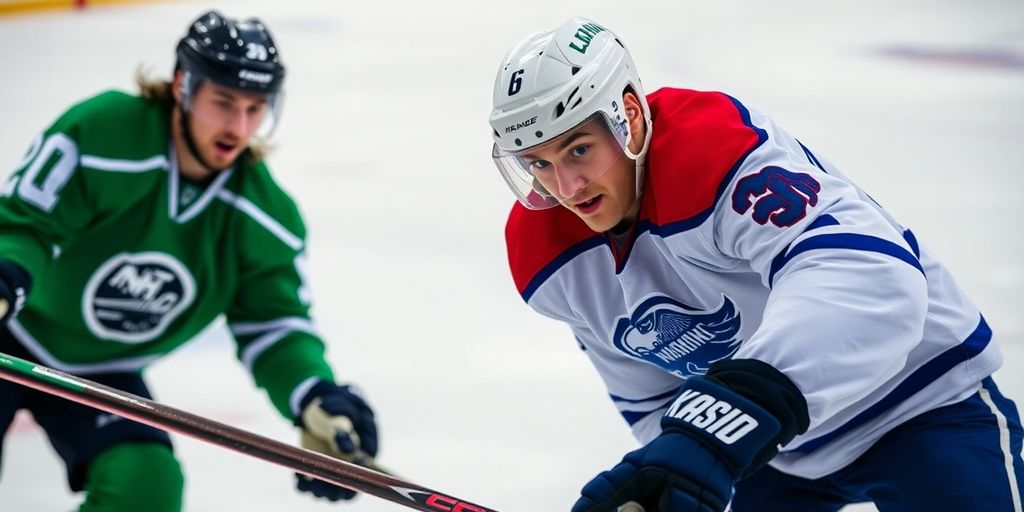Betting on hockey can be thrilling, but it’s also a game of strategy and knowledge. Whether you’re a seasoned bettor or just starting out, understanding the ins and outs of hockey betting is crucial for success. This guide will walk you through the basics, research techniques, and advanced strategies to help you make informed bets and hopefully come out ahead.
Key Takeaways
- Know the key terms and types of hockey bets before placing any wagers.
- Always research team performance and player stats to make better betting decisions.
- Pay attention to goaltender stats, as they can significantly influence game outcomes.
- Watch for momentum shifts during games to capitalize on in-game betting opportunities.
- Manage your bankroll wisely to ensure responsible betting and minimize losses.
Understanding Betting on Hockey Basics
So, you want to get into hockey betting? Awesome! It’s a fast-paced, exciting world, but before you place your bet, it’s good to know the basics. Think of this section as your Hockey Betting 101 course. We’ll cover the key terms, the different types of bets you can make, and the most popular markets to explore. Don’t worry, it’s not as complicated as it might seem at first.
Key Betting Terminology
Okay, let’s start with the lingo. You’ll hear terms like “moneyline,” “puck line,” and “over/under” thrown around a lot. The moneyline is simply betting on who will win the game. The puck line is like a spread in other sports, adding a handicap to the favorite. Over/under is betting on the total number of goals scored. There are also terms like “odds,” which tell you how much you stand to win, and “bankroll,” which is the amount of money you’ve set aside for betting. Knowing these terms is the first step to understanding what’s going on.
Types of Bets Available
Now, let’s talk about the different ways you can actually bet on a hockey game. It’s not just about picking the winner. Here’s a quick rundown:
- Moneyline: As mentioned, picking the outright winner.
- Puck Line: Betting on the margin of victory with a handicap.
- Over/Under: Betting on the total goals scored by both teams.
- Prop Bets: These are bets on specific events within the game, like which player will score first or how many saves a goalie will make.
Popular Betting Markets
So, where do people actually put their money? Some of the most popular betting markets in hockey include:
- NHL: Of course, the National Hockey League is the biggest and most popular market.
- International: Tournaments like the World Championships and the Olympics also draw a lot of betting action. You can find NHL betting strategies online.
- AHL: The American Hockey League is another popular market, especially for those who follow the minor leagues.
Understanding these markets is key because different leagues and tournaments can have different styles of play, which can affect your betting strategy. For example, international hockey might be more high-scoring than the NHL, so the over/under might be set higher.
Research and Analysis for Successful Betting
Analyzing Team Performance
Okay, so you want to win some money betting on hockey? You can’t just pick teams based on a hunch or because you like their jerseys. You need to dig into how teams are actually doing. Look at their win-loss records, of course, but go deeper. How are they performing at home versus away? Are they on a winning streak, or are they in a slump? Who are their key players, and how are those players performing lately? A team’s overall performance is more than just a number; it’s a story waiting to be read.
Utilizing Advanced Statistics
Forget just looking at goals and assists. The world of hockey stats has exploded. We’re talking Corsi, Fenwick, PDO… it can seem like alphabet soup. But trust me, these numbers can tell you a lot. Corsi and Fenwick, for example, give you an idea of puck possession – which team is spending more time in the offensive zone? PDO is a bit controversial, but it can help identify teams that are getting lucky (or unlucky) and might be due for a regression. Don’t be afraid to explore NHL betting with these advanced stats; they can give you an edge.
Importance of Recent Form
What a team did three months ago doesn’t matter nearly as much as what they’ve been doing lately. A team that started strong might be struggling with injuries or fatigue. Conversely, a team that had a slow start might have found its groove. Pay close attention to the last 5-10 games. Are they scoring more goals? Are they allowing fewer? Has their power play improved? Recent form is a much better indicator of future performance than season-long averages.
Remember, no amount of analysis guarantees a win. Hockey is unpredictable. But the more you know, the better your chances of making informed bets. Don’t just guess; research, analyze, and make smart choices.
Here’s a quick example of how you might track a team’s recent performance:
| Team | Last 5 Games | Goals For | Goals Against | Power Play % |
|---|---|---|---|---|
| Team A | W-L-W-W-L | 18 | 12 | 25% |
| Team B | L-L-W-L-L | 9 | 15 | 10% |
Based on this, Team A is clearly in better form than Team B. This doesn’t guarantee a win if they play each other, but it gives you a solid starting point for your betting decision.
Evaluating Goaltenders and Special Teams
Impact of Goaltenders on Outcomes
Goaltenders are super important in hockey; they can totally change a game. A hot goalie can steal wins, while a struggling one can cost their team big time. Their performance directly affects the odds and the final score. It’s not just about stopping the puck; it’s about controlling rebounds, making smart plays, and keeping the team confident. A good goalie can really be the backbone of a team, especially in close games. You can’t just look at wins and losses; you need to dig deeper to see how they’re really doing. For example, a goalie might have a bad record because the team in front of them isn’t playing well defensively. So, always do your homework before placing that bet!
Assessing Goalie Performance
Evaluating a goalie goes way beyond just looking at their goals-against average (GAA). While GAA gives you a basic idea, it doesn’t tell the whole story. Here’s what I look at:
- Save Percentage (SV%): This is key. It tells you how many shots a goalie stops, giving you a better picture of their skill. A high save percentage is a good sign.
- High-Danger Save Percentage (HDSV%): This stat focuses on the tough shots, the ones from right in front of the net. A goalie who can stop those is clutch.
- Quality Starts: This metric measures how often a goalie has a game that’s above average. It shows consistency.
Don’t forget to consider the team in front of the goalie. A goalie on a team that allows a ton of shots will naturally have a higher GAA than a goalie on a strong defensive team. Context is everything!
Understanding Special Teams Influence
Special teams, like the power play and penalty kill, can really swing a hockey game. A team with a killer power play can score quickly and change the momentum, while a solid penalty kill can shut down the opponent’s chances. Here’s what to keep in mind:
- Power Play Percentage (PP%): This tells you how often a team scores when they have a man advantage. A high PP% is a major weapon.
- Penalty Kill Percentage (PK%): This shows how well a team prevents goals when they’re shorthanded. A good PK% can save a game.
- Discipline: How often does a team take penalties? Too many penalties can give the other team too many power play chances. Look at peer-to-peer wagering to see how these stats affect the odds.
Recognizing Momentum Shifts in Games
Identifying Momentum Changes
Okay, so you’re watching a hockey game, maybe you’ve even got some money riding on it. It’s not enough to just see who’s scoring; you need to feel the game. Momentum shifts are real, and they can change everything. Keep an eye out for things like a sudden burst of energy from one team after a big hit, a power play goal that swings the emotional tide, or even just a change in the pace of play. Sometimes it’s obvious, like when a team scores two quick goals. Other times, it’s more subtle, like a series of sustained offensive zone possessions. Recognizing these shifts is the first step to successful betting.
Capitalizing on Game Dynamics
Once you’ve spotted a momentum shift, what do you do with it? Well, that depends on the type of bet you’re looking to make. If a team is suddenly playing with a ton of confidence, they might be a good bet to cover the puck line. If the game has been low-scoring but one team is starting to dominate, the over/under might be worth a look. It’s all about reacting quickly and making smart decisions based on what you’re seeing. Don’t just blindly follow the odds; use your own observations to find value. Remember to analyze goalie performance too.
Strategies for In-Game Betting
In-game betting is where recognizing momentum really pays off. Here are a few things to keep in mind:
- Watch the first few minutes of each period: Teams often come out with renewed energy after the intermission, which can lead to early goals or shifts in momentum.
- Pay attention to penalties: A power play can completely change the complexion of a game, so be ready to adjust your bets accordingly.
- Don’t be afraid to hedge your bets: If you see the momentum shifting against your original pick, consider placing a small bet on the other team to minimize your losses.
It’s important to remember that momentum isn’t everything. A team can have all the momentum in the world, but a lucky bounce or a great save can quickly turn the tide. Always consider other factors like team matchups, injuries, and goalie performance before making any bets.
Here’s a simple table to illustrate how momentum can affect betting decisions:
| Momentum Shift | Potential Bet | Rationale and the list goes on. It’s about being adaptable and ready to react to the flow of the game. Also, remember to practice responsible betting.
Effective Bankroll Management Techniques
Betting on hockey can be a blast, but it’s super important to handle your money the right way. Think of it like this: you wouldn’t go grocery shopping without a list and a budget, right? Same goes for betting. If you don’t manage your bankroll well, you might as well throw your money into a black hole. Let’s break down some simple ways to keep your betting on track.
Setting Betting Limits
Okay, first things first: figure out how much you can actually afford to lose. Seriously. This isn’t about how much you want to bet, but how much you can comfortably part with if things go south. Once you have that number, stick to it. Don’t even think about going over.
Here’s a simple way to set limits:
- Calculate your disposable income: What’s left after bills, rent, food, etc.?
- Allocate a percentage: Maybe 1-5% of that disposable income for betting.
- Set daily/weekly limits: Divide your total betting budget into smaller chunks.
Managing Risk and Losses
So, you had a bad day? It happens. The worst thing you can do is try to win it all back in one go. That’s how people end up in trouble. Instead, take a deep breath and stick to your plan. Reduce your stake sizes, or even take a break for a day or two. It’s all about staying cool and collected. Effective bankroll management strategies is key to long-term success.
Remember, betting should be fun. If it starts feeling like a chore, or if you’re chasing losses, it’s time to step away. There’s no shame in admitting you need a break. Your mental health and financial well-being are way more important than any bet.
Practicing Responsible Betting
Responsible betting is more than just setting limits; it’s a whole mindset. It’s about being aware of the risks, understanding the odds, and knowing when to stop. Here are a few things to keep in mind:
- Don’t bet when you’re emotional: Whether you’re angry, sad, or overly excited, emotions can cloud your judgment.
- Treat betting as entertainment, not a source of income: It’s a hobby, not a job.
- Be honest with yourself: If you think you might have a problem, seek help. There are resources available to support you.
Here’s a table showing how different stake sizes impact your bankroll over a series of bets:
| Bet Number | Bankroll Size | Stake (2%) | Stake (5%) | Stake (10%) |
|---|---|---|---|---|
| 1 | $1000 | $20 | $50 | $100 |
| 2 | $980 | $19.60 | $49 | $98 |
| 3 | $960.40 | $19.21 | $48.02 | $96.04 |
Advanced Tools for Hockey Betting Metrics
Using Analytics Platforms
Okay, so you want to get serious about hockey betting? Ditch the gut feelings and start looking at the numbers. There are a bunch of analytics platforms out there that can give you an edge. These platforms collect tons of data, from player stats to team performance, and present it in a way that’s (hopefully) easy to understand. Think of it as having a scout in your pocket, but instead of watching games, they’re crunching numbers.
- MoneyPuck: A great resource for expected goals and other advanced stats.
- Natural Stat Trick: Another solid option for digging into team and player metrics.
- Evolving Hockey: Offers a variety of tools, including WAR (Wins Above Replacement) models.
Using these platforms isn’t about finding a magic formula. It’s about getting a better understanding of what’s actually happening on the ice, beyond what you see with your own eyes. It’s about making informed decisions, not just guessing.
Correlation Between Metrics and Outcomes
So, you’ve got all this data. Now what? The key is figuring out which metrics actually matter. Does a high shooting percentage really translate to more wins? Does a team’s faceoff win percentage have a significant impact? This is where correlation comes in. You need to look at how different metrics relate to game outcomes. For example, a strong correlation between save percentage and winning percentage is pretty obvious, but what about something less obvious, like the relationship between zone entries with possession and goals scored?
| Metric | Correlation to Wins (Example) | Notes |
|---|---|---|
| Save Percentage | High | Consistently strong indicator of team success. |
| Corsi For % (CF%) | Moderate to High | Indicates puck possession; higher CF% often leads to more scoring chances. |
| Power Play Conversion % | Moderate | Crucial for capitalizing on opportunities. |
Integrating Data into Betting Strategies
Alright, you’ve got the data, you know which metrics correlate to wins, now it’s time to put it all together. This is where you develop your betting strategies. Don’t just blindly follow the numbers, though. Consider things like injuries, coaching changes, and team morale. Data is a tool, not a crystal ball. Think about how goaltender stats can influence your betting strategy.
Here’s a basic approach:
- Identify Key Metrics: Focus on a few metrics that you believe are most important (e.g., save percentage, expected goals).
- Compare Teams: Look at how teams stack up against each other in those key metrics.
- Consider Context: Factor in injuries, recent performance, and other relevant information.
Exploring Different Types of Hockey Bets
So, you’re ready to put some money down on a hockey game? Awesome! But before you do, it’s good to know the different ways you can bet. It’s not just about picking who wins (though that’s definitely an option!). There’s a whole bunch of stuff you can wager on, and understanding it all can make things way more interesting, and maybe even profitable. Let’s break down some of the most common types of hockey bets.
Moneyline Bets Explained
Okay, let’s start with the simplest one: the moneyline. This is just betting on who you think will win the game, straight up. No point spreads, no fancy stuff. The odds will tell you who the favorite is (they’ll have a minus sign next to their number, like -150) and who the underdog is (they’ll have a plus sign, like +130). A winning bet on the underdog usually pays out more, because, well, they’re less likely to win. It’s all about risk and reward. If you’re new to betting, this is a great place to start. It’s easy to understand and gets you right into the action.
Puck Line and Over/Under Bets
Alright, now we’re getting into slightly more complex territory. The puck line is hockey’s version of the spread in other sports. Basically, it’s a handicap given to the underdog. The favorite has to win by a certain number of goals (usually 1.5) for you to win your bet. So, if you bet on the favorite on the puck line, they need to win by at least two goals. If you bet on the underdog, they can either win the game outright or lose by only one goal, and you still win your bet. Check out this puck line example for more information.
The over/under, also known as the totals bet, is about the total number of goals scored in the game by both teams. The sportsbook will set a number (like 5.5), and you bet on whether the total goals scored will be over or under that number. It doesn’t matter who wins the game; all that matters is the combined score.
Prop Bets and Their Value
Prop bets, short for proposition bets, are wagers on specific events within the game that don’t necessarily affect the final outcome. These can be anything from which player will score the first goal to how many penalty minutes a team will get. Prop bets can be a lot of fun because they let you focus on specific aspects of the game. They can also offer good value if you know a lot about individual players or teams. Here are a few examples:
- Will a specific player score a goal?
- How many shots on goal will a certain player have?
- Will there be a power-play goal scored in the first period?
Prop bets can be a great way to add excitement to a game, especially if you’re already familiar with the teams and players involved. However, it’s important to remember that they can be more unpredictable than other types of bets, so it’s a good idea to do your research before placing a wager.
There are other types of bets too, like parlays (combining multiple bets into one for a bigger payout), 60-minute bets (betting on the score at the end of regulation time), and grand salamis (betting on the total goals scored across all games in a league on a given day). But these three – moneyline, puck line/over-under, and prop bets – are the most common and a good starting point for any hockey bettor.
Wrapping It Up: Your Hockey Betting Journey
So, what’s the takeaway here? Betting on hockey can be a wild ride, but it doesn’t have to be a gamble. Use the stats, keep an eye on player conditions, and don’t forget to trust your instincts. Remember, it’s all about finding that sweet spot between analysis and gut feeling. And hey, if it ever feels like too much, just take a step back. Betting should be fun, not a headache. So gear up, do your homework, and enjoy the game!
Frequently Asked Questions
What is the best way to start betting on hockey?
The best way to begin betting on hockey is to learn the basics first. Understand the different types of bets, like moneyline and puck line, and familiarize yourself with hockey terms.
How important is team research before placing a bet?
Doing research on teams is very important. Look at their recent performances, player injuries, and head-to-head matchups to make informed bets.
What role do goaltenders play in hockey betting?
Goaltenders are crucial in hockey. Their performance can greatly affect the game’s outcome, so always check their save percentages and recent form.
Can I bet on hockey games while they are happening?
Yes, live betting is an option. It allows you to place bets as the game unfolds, which can be beneficial if you notice momentum shifts.
What is bankroll management in betting?
Bankroll management means keeping track of your betting money. Set limits on how much you can bet and stick to them to avoid losing too much.
Are there specific metrics I should look at for betting?
Yes! Key metrics include team stats like puck possession, shooting percentages, and goalie performance. These can help you make better betting decisions.













